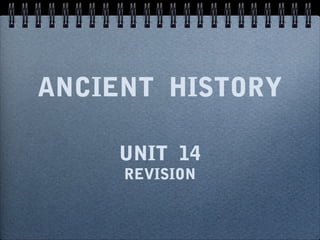ANCIENT HISTORY
•Download as PPT, PDF•
3 likes•3,337 views
REVIEW. UNIT 14. SCIENCE. FIFTH GRADERS
Report
Share
Report
Share

Recommended
More Related Content
What's hot
What's hot (20)
Similar to ANCIENT HISTORY
Similar to ANCIENT HISTORY (20)
More from susanamt_etg
More from susanamt_etg (20)
Tutorial: cómo subir una entrega en el Aula Virtual

Tutorial: cómo subir una entrega en el Aula Virtual
Recently uploaded
https://app.box.com/s/7hlvjxjalkrik7fb082xx3jk7xd7liz3TỔNG ÔN TẬP THI VÀO LỚP 10 MÔN TIẾNG ANH NĂM HỌC 2023 - 2024 CÓ ĐÁP ÁN (NGỮ Â...

TỔNG ÔN TẬP THI VÀO LỚP 10 MÔN TIẾNG ANH NĂM HỌC 2023 - 2024 CÓ ĐÁP ÁN (NGỮ Â...Nguyen Thanh Tu Collection
Making communications land - Are they received and understood as intended? webinar
Thursday 2 May 2024
A joint webinar created by the APM Enabling Change and APM People Interest Networks, this is the third of our three part series on Making Communications Land.
presented by
Ian Cribbes, Director, IMC&T Ltd
@cribbesheet
The link to the write up page and resources of this webinar:
https://www.apm.org.uk/news/making-communications-land-are-they-received-and-understood-as-intended-webinar/
Content description:
How do we ensure that what we have communicated was received and understood as we intended and how do we course correct if it has not.Making communications land - Are they received and understood as intended? we...

Making communications land - Are they received and understood as intended? we...Association for Project Management
God is a creative God Gen 1:1. All that He created was “good”, could also be translated “beautiful”. God created man in His own image Gen 1:27. Maths helps us discover the beauty that God has created in His world and, in turn, create beautiful designs to serve and enrich the lives of others.
Explore beautiful and ugly buildings. Mathematics helps us create beautiful d...

Explore beautiful and ugly buildings. Mathematics helps us create beautiful d...christianmathematics
Recently uploaded (20)
Kodo Millet PPT made by Ghanshyam bairwa college of Agriculture kumher bhara...

Kodo Millet PPT made by Ghanshyam bairwa college of Agriculture kumher bhara...
TỔNG ÔN TẬP THI VÀO LỚP 10 MÔN TIẾNG ANH NĂM HỌC 2023 - 2024 CÓ ĐÁP ÁN (NGỮ Â...

TỔNG ÔN TẬP THI VÀO LỚP 10 MÔN TIẾNG ANH NĂM HỌC 2023 - 2024 CÓ ĐÁP ÁN (NGỮ Â...
General Principles of Intellectual Property: Concepts of Intellectual Proper...

General Principles of Intellectual Property: Concepts of Intellectual Proper...
Making communications land - Are they received and understood as intended? we...

Making communications land - Are they received and understood as intended? we...
Explore beautiful and ugly buildings. Mathematics helps us create beautiful d...

Explore beautiful and ugly buildings. Mathematics helps us create beautiful d...
ICT Role in 21st Century Education & its Challenges.pptx

ICT Role in 21st Century Education & its Challenges.pptx
HMCS Max Bernays Pre-Deployment Brief (May 2024).pptx

HMCS Max Bernays Pre-Deployment Brief (May 2024).pptx
This PowerPoint helps students to consider the concept of infinity.

This PowerPoint helps students to consider the concept of infinity.
Micro-Scholarship, What it is, How can it help me.pdf

Micro-Scholarship, What it is, How can it help me.pdf
Basic Civil Engineering first year Notes- Chapter 4 Building.pptx

Basic Civil Engineering first year Notes- Chapter 4 Building.pptx
ANCIENT HISTORY
- 2. PRE - ROMAN TIMES They are descendents from the first inhabitants of the Iberian Peninsula during prehistoric times. Both Celts and Iberians were organized in tribes and they lived in walled villages situated high up on hills- to keep out attackers-. Celts: were situated in the Central Plateau and the Cantabrian coast. They lived in peace and in tribes. They were expert metal workers and farmers (most people bred animals and cultivate cereals). They did not trade much. They built round houses so the streets were not clearly definited. IBERIANS: were situated on the Mediterranean Coast(south and East) so they traded with the colonies that arrived to the peninsula such as Phoenicians, Greeks and Carthaginians. They made their own coins. They were farmers and craftsmen – they created wonderful sculptures -. They knew how to write.
- 3. COLONISING CIVILIZATIONS Phoenicians: they came from Asia. They were expert sailors and traders. They founded colonies such as Gadir, Malaca or Abdera. 7th century B.C. Greeks: They came from Greece and settled on the Mediterranean coast. around the 6th century B.C. They sold ceramics and bought salt, esparto grass and metals. Carthaginians: They arrived from Africa around the 3rd century. They inhabited the Balearic Islands and some territories such as Cartago Nova (Cartagena). They wanted to control the Mediterranean world so they came not just to trade but also willing to conquer new territories.
- 4. ROMAN HISPANIA They landed in Emporion in the year 218 B.C.E. They were fighting against the Carthaginians in the Punic wars. They expelled them from the Peninsula and they decided to occupy the place. By the year 19 B.C. they had conquered all the territory (including the colonies and the celts and Iberians). The Romans divide the territory into provinces. Each province had a governor (maintein order and collect taxes). They adopted the Roman Law. Latin became the official language. First, they worshipped Roman gods and goddesses. Later. Christianity became the official religion. Roman society was divided into free people and slaves. Free woman had fewer rights than free men. They built many public monuments: theatres, amphitheatres, circuses, aqueducts...
Editor's Notes
- {}